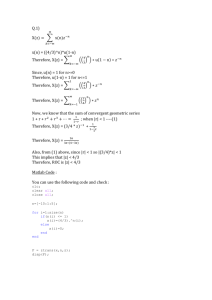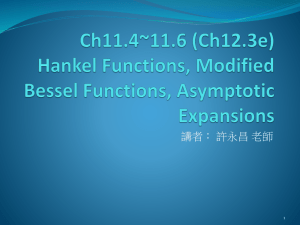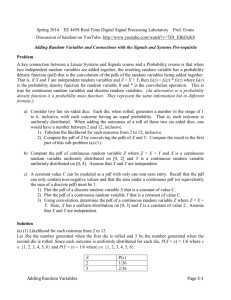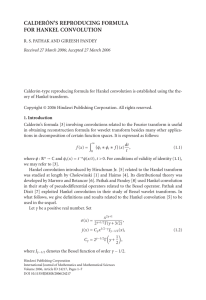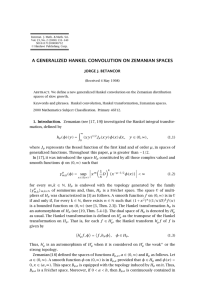Document 10441531
advertisement
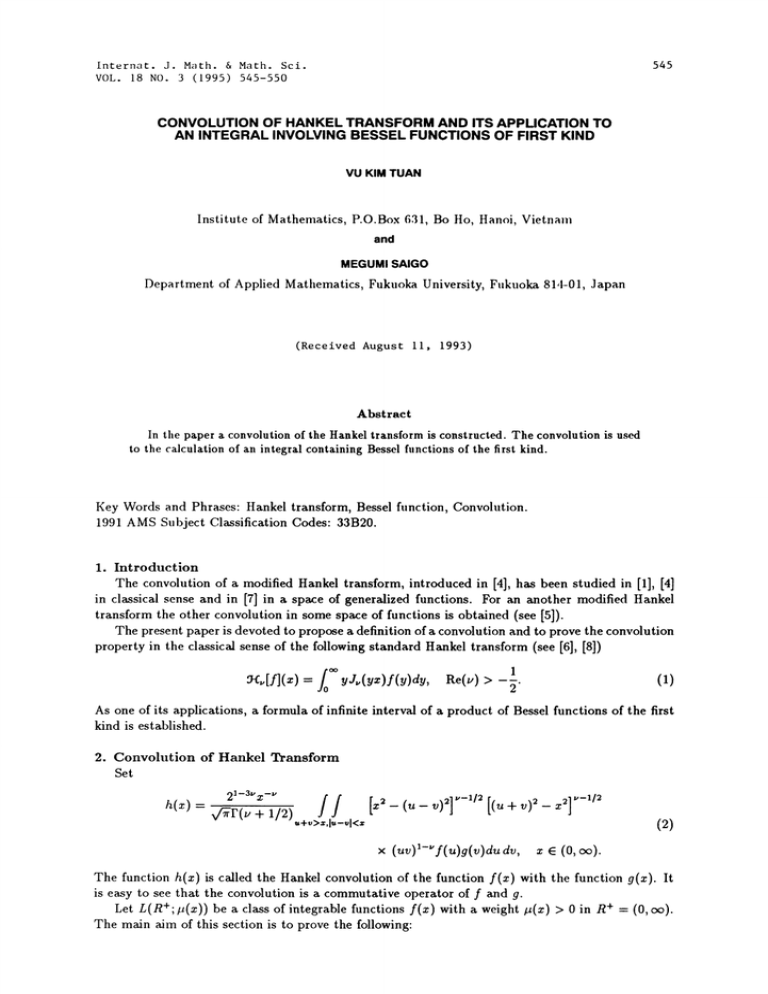
545 Internat. J. Math. & Math. Sci. VOL. 18 NO. 3 (1995) 545-550 CONVOLUTION OF HANKEL TRANSFORM AND ITS APPLICATION TO AN INTEGRAL INVOLVING BESSEL FUNCTIONS OF FIRST KIND vu KIM TUAN Institute of Mathematics, P.O.Box 631, Bo tto, Hanoi, Vietnam MEGUMI SAIGO Department of Applied Mathematics, Fukuoka University, Fukuoka 8l,l-0l, Japan (Received August II, 1993) Abstract In the paper a convolution of the Hankel transform is constructed. The convolution is used to the calculation of an integral containing Bessel functions of the first kind. Key Words and Phrases: Hankel transform, Bessel function, Convolution. 1991 AMS Subject Classification Codes: 33B20. 1. Introduction The convolution of a modified Hankel transform, introduced in [4], has been studied in [1], [4] [7] in a space of generalized functions. For an another modified Hankel transform the other convolution in some space of functions is obtained (see [5]). The present paper is devoted to propose a definition of a convolution and to prove the convolution property in the classical sense of the following standard Hankel transform (see [6], [8]) in classical sense and in 9[f](x) yJ(yx)f(y)dy, (1) Re(,) > 2 As one of its applications, a formula of infinite interval of a product of Bessel functions of the first kind is established. 2. Convolution of Hankel Transform Set h(x) 2-3’x-’ f/ V/.r( y + 1/2) ,,+v>,l,,-,,l< x (uv)’-"f(u)g(v)dudv, x, _ () (0, The function h(x) is called the Hankel convolution of the function f(x) with the function g(x). It is easy to see that the convolution is a commutative operator of f and g. Let L(R+;p.(x)) be a class of integrable functions f(x) with a weight p(x) > 0 in R + (0, oo). The main aim of this section is to prove the following: V. K. TUAN AND M. SAIGO 546 Theorem. Let Re(u) > and f(z),g(z) E L(R." 2 and there hoils the convolution property 9([h](z) /’). Then the function h,(z) in (’2) exists x-9f[f](x)f.[g](x), (3) where :f,, is the Hankel transform (1). Proof. It is well known [6, (2.12.42.15)] that fo - J.( zt )J.( ut J( vt )dt (4) VTv( + /2) where Re(u) > 2 and +() >/ v()’ v() () 0, < 0. 0, Since co,( J,,(x) 2 4 ) +o (5) o (), +0), (see [3]) it is easy to conclude that there exists such positive number C independent of z that and z-J.(x) L(R+) when Re(u) > ( . (0, oo) Therefore we have t’-"J.(xt)J(ut)J.(vt)dt (6) <= Cz()- where C is independent of x, u, v and N. In particular, the help of the estimate (6) we have . Ih()l N C (ince I(),() e (.; Cza)- 1 t-EJ(t), dt mng use the formul (2) and (4) with lf()(v)ldd < Thus the function h() in (2) , exists. urthermore, applying the ubini theorem, e obtain .. . t-".(t) Here we have used the estence N the genkel transform defined by ; (R+; ) (see [2], [8]). Moreover, we notice the fct x[I]() from [2, t (t) (t)()() o (), ( +0) for Ie (1) Nr () Nnctions from (,; ) p. 74]. Therefore, if we set k(t) t-"gf[f](t)rf.[g](t), (S) CONVOLUTION OF HANKEL TRANSFORM W 547 htve () On the other hand we o("), () +0). ( have I:c.[/](t)l V/’J =< u v/’f u du , C < e (0,), (0) and lherefore, o (,--’), ( ,() Since Re(u) > 1/2, from (9), can be rewritten in the form (11) we +). L conclude that k(t) (R+" ). Therefore the form,,la (7) C[](). h(,) ttence, by using the inversion formula of the Unkel transform in the class L(R+; fir,., [3Q[k]] (z) (see [2], [8]): (12) k(z), we obtain (13) 3f[h](z). k(z) As k(z) has the form (8), the formula (13) coincides with the formula (3). Thus the theorem is proved. 3. Application As an application of Theorem we consider the integral j--1 with a, > 0 (j 0, 1,-.., n) and Re(y,) => 0 (j n). We 1,.,9 f,*’’"’"" (a0, a, a,,) will prove that 0 when ao>a,+.-’+a,, and n-3 <Re(uo)< Re(u,)+. We know that it is valid for n (see [6, (2.12.31.1)] for the case Re(y,) 0, and [6, (2.12.35.12)] for the case Re(ya) > 0). Suppose that it is valid for every k __< n. We have to prove it for the case k n + 1. Put fi (t2+y) -’12 gO,,,-.-,, ,,,.. ,,, (t, a,,... a,) By using (5) we have (t a,,)=O(t*) gO,,,...,,(t,a Yl ,’"Yn +0) (14) Suppose that 2 Then from (14) we conclude that formula (10) we obtain 0..--. " (t,a ...,a,,) 9u,.Y!,, .... (t,a, o [a’’ ,,. Lain, Re(v,)+ n-3 2 ") L (R+; v/ (z aa,... tou,,.,u" Since < Re(vo) < ’’’, a,)] () t ’’ .... (z, +O,z a, Therefore, by using the +). a.) (15) 548 V. K. TUAN AND M. SAIGO the forr, mla (15) can ie real as ,, But by (z,a,...,,) ,o +c). +O,x l}o assumplion we have ,n ,1, ,Yn when z > and by (x 0 a +’’" + an. Therefore .... (x (F, al,..-, an) we have t’’t’"+’ _ a,,) E L (R+; V’) a, (12) Analogously, 0 (X an+l) (R+. v/’) i and under the conditions 2 .... Since g,’’, ,.+, (t, al, < Re(uo) < Re(u.+,)- 1. a.+,) /’ .... t-a"’’’o,, ,. (t,a,, a.)a’’’’+’o.+, (t, a.+,), then by using the theorem we obtain 21-3’x- a.)] (t)] (x) (y,a, Yn+l (16) // vr(,o + /2) u+v>z,lt,-vl<z X .... (u,a Since Yn cr’0’r’l .’".l/."r’r’ (it, al, ’/1 ", art) fo,.+, (v, a.+l du dv. a,)=0 when u>a+..-+a, and f=’o,=’,,+, (V, an+l) 0 when v > a.+ provided that n-3 < a(.o) < 3=1 we conclude from Re(g0)- Re(tn+l) < -1, (7) + a.+ (J8) (16) that f,.’o,,,,-,.+, (z 1, under (17). The formula a(,) + --7-- (18) ,Yn+l can a, ln+l 0 when z > a +--. be analytically continued to the domain "+z -1 < Thus we have proved (.o) < 2 (",)+ 3=1 n- 3 2 CONVOLUTION OF HANKEL TRANSFORM 549 Corollary. Let -1 <Re(vo)< Re(u.,)+ ’) % >O(j= 1,...,n) with ao > a+..-+ anti Th en fot’+lJo(ao t) fi (t2 + y)-"’/2J,, (%t2 + y)dt (19) O. )=0 The formula (19) is a generalization of the formulae (2.12.44.7) (the case and (2.12.44.8) (the case Re(yi) > 0,--., Re(y,,) > 0)in [6]. y, yl 0) Acknowledgement. The work of the first author was supported, in part, by the National Basic Research Program in Natural Sciences, Vietnam, and by the Alexander von Humboldt Foundation. References [1] F.M. Cholewinski: Hankel Convolution Complex Inversion Theory, Mem. Amer. llalh. Soc. Vol. 58, 1965. Ditkin and A.P. Prudnikov: lntegral Transforms and Operational Calculus, Pergamon Press, Oxford-London-Edinburgh-New York-Paris-Frankfurt, 1965. [3] A. Erddlyi, W. Magnus, F. Oberhettinger and R.P. Soni: Higher Transcendental Functions, [2] V.A. Vol. , McGraw-Itill, New York-Toronto-London, 1953. [4] I.I. Hirschman, Jr." Variation diminishing Ha.nkel transforms, d. Analyse Math. 8(1960/61), 307-336. [5] Nguyen Thanh Hal and S.B. Yakubovich: The Double Mellin-Barnes Type Integrals and Their Applications to Convolution Theory, World Scientific, Singapore-New Jcrsev-London-itong Kong, 1992. , Special de Sousa Pinto: A generalized Hankel convolution, SIAM J. Math. Anal. 16 (1985), [6] A.P. Prudnikov, Yu.A. Brychkov and O.I. Marichev: Integrals and Series, Vol. Functions, Gordon & Breach, New York-London-Paris-Tokyo, 1986. [7] J. 1335-1346. [8] E.C. Titchmarsh: 1948. Introduction to the Theory of Fourier Integrals, Oxford Univ. Press, Oxford,


